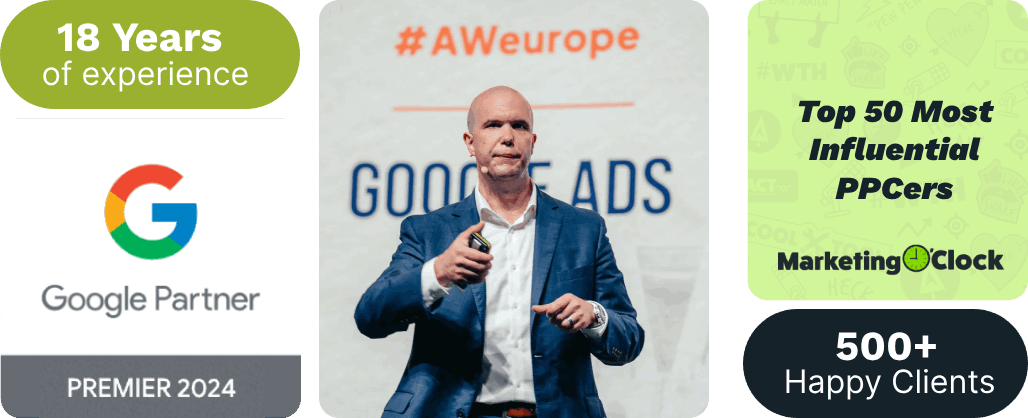The Google Ads bidding strategy is one of the most important aspects of a successful Google Ads campaign. If you’re not bidding correctly, you could be wasting a lot of money on ads that aren’t reaching their potential.
In this overview, we’ll discuss each Google Ads bidding strategy and give you tips on when to use them and when to avoid them so you can scale your campaigns and get the most out of your advertising budget!

Maximize Clicks Bidding Strategy
Maximize Clicks bidding strategy is an automated bidding strategy. It allows you to set an average daily budget for your ad campaign and then automatically sets your bids to help you get the most clicks possible within that budget.
Consider this Google Ads bidding strategy a preliminary strategy if you’re just starting out with Google Ads and you need to gather data.
When to Use the Maximize Clicks Bidding Strategy:
– You’re new to Google Ads and don’t have much data and experience to start with
– You want to drive traffic to your website or landing page
– You have a limited budget for your Google Ads campaign
– You’re in a market where competition is not that high

When Not to Use the Maximize Clicks Bidding Strategy:
– Your top priority is getting conversions
– You’re trying to generate leads or sales from your Google Ads campaign
– You’re using a broad keyword match type
Google defines Maximize Clicks bidding strategy as the simplest bidding strategy–just set your budget and leave the rest to Google.
However, it’s still You vs. Google and you still have a lot of factors to consider when using Maximize Clicks.
If you want to know more about the Maximize Clicks bidding strategy, read our guide blog here. You can also watch John’s discussion about this Google Ads bidding strategy here.
Maximize Conversions Bidding Strategy
The Maximize Conversions bidding strategy is used by advertisers who want to generate as many conversions as possible within their budget. This results in the CPA (cost per acquisition) being high, but if there are frequent conversions, that CPA will start to reduce.
When to Use the Maximize Conversions Bidding Strategy:
– You want the maximum number of conversions in a short period of time
– You’re not worried about the cost per acquisition or the value of the sale
– You’re running a Performance Max campaign

When Not to Use the Maximize Conversions Bidding Strategy:
– You have low volume traffic and low intent, this Google Ads bidding strategy only works well with high conversions
If you want to learn more about Maximize Conversions bidding strategy to scale your Google Ads campaigns, you can read our separate guide about it here. You can watch John’s discussion about this Google Ads bidding strategy in this video.
Maximize Conversion Value Bidding Strategy
The Maximize Conversion Value bidding strategy is quite similar to Maximize Conversions bidding strategy but it focuses on the size of the conversion.
It’s a Google Ads bidding strategy designed to maximize the total revenue of your campaigns.
However, it can get very aggressive because it tries to get conversions quickly and constantly on a daily basis. That being said, it might focus on selling your lower-priced products if it’s easier to get a sale with those.
When to Use the Maximize Conversion Value Bidding Strategy:
– You want to generate as many conversions as possible from your ad campaign
– You’re comfortable with Google Ads adjusting your bids based on conversion data

When Not to Use the Maximize Conversion Value Bidding Strategy:
– You have a limited budget
– You don’t have enough conversion data for Google Ads to optimize your bids
– You’re new to Google Ads and don’t have much experience with bidding strategies
Want to know more about the Maximize Conversion Value bidding strategy? Read our blog here or watch John’s discussion about this Google Ads bidding strategy here.
Target Impression Share Bidding Strategy
The Target Impression Share bidding strategy used to be called Target Search Impression Share. When using this Google Ads bidding strategy, your campaign will prioritize top placement on Google’s SERPs. This is John’s least favorite bidding strategy because it doesn’t care about conversions. Target Impression Share bidding is all about visibility, which makes it the “vanity” Google Ads bidding strategy.
When to Use Target Impression Share Bidding Strategy:
- You’re running brand campaigns in a high-competition market
- You prioritize placement over conversions

When Not to Use Target Impression Share Bidding Strategy:
- You need conversions
- You want a bidding strategy that can easily adjust to your goals. Target Impressions Share bidding takes longer to adjust compared to other bidding strategies
- You trust John when he says it’s his least favorite bidding strategy
Learn more about why John doesn’t like Target Impression Share bidding in this video.
Manual CPC Bidding Strategy
Generally, the Manual CPC bidding strategy is great for advertisers who want precise control over where your ad budget goes. With this bidding strategy, you set a maximum bid for each keyword or ad group in your campaign.

You can use Manual CPC bidding with or without Enhanced CPC.
Manual CPC with Enhanced CPC
Manual CPC with Enhanced CPC is an audience-based and conversion-focused strategy. But beware because it can get too aggressive when you are testing it, whether it’s focusing on conversions or conversion value. This is because Enhanced CPC works by adjusting your bids automatically in the attempt to maximize your conversions. In short, using it with Enhanced CPC cancels out “manual.”
This bidding strategy is similar to maximized conversions, you just set the minimum it can go down to. It will go over your set CPC.
Manual CPC without Enhanced CPC
Many times, Manual CPC without Enhanced CPC is a better way to use Manual CPC bidding because you’re not going to allow maximize conversions to kick in and shoot your bids too high.
Manual CPC without Enhanced CPC is where you can control your bids. This is not a conversion and audience-based strategy; it focuses on placement.

When to Use Manual CPC Bidding Strategy:
– You’re trying to boost brand awareness on keywords you want
– You want to experiment and test out keywords and strategy
– You have a specific CPC bid in mind for each keyword in your ad campaign
– You’re running lead generation campaigns
– You have to be at the top of the SERP and couldn’t get there with Maximize Conversions bidding
When Not to Use Manual CPC Bidding Strategy:
– You’re using Broad Match
– You’re not confident enough to set your bids for specific keywords or ad groups
If you want to learn more about how to use Manual CPC bidding strategy to your advantage, we’ll be releasing a blog about it soon! In the meantime, you can watch John discuss it here.
Conclusion
There are different bidding strategies available on Google Ads, and choosing the right one for your campaign can make all the difference between success and failure.
As we always say, there isn’t a one-size-fits-all approach in Google Ads, even with bidding strategies. But we hope this Google Ads bidding strategies overview helped you in one way or another.
Author
Joan is the YouTube Growth Manager at Solutions 8. When she’s off the clock, you’ll find her chilling with her 10 fur babies, pushing her limits in CrossFit sessions, or basking in the serenity of the beach.
 Joan Porio
Joan Porio













